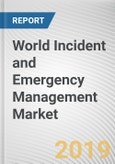There are several key drivers, restraints and opportunities influencing the market growth. Today, concerns over rising terrorists attacks and destruction caused by natural calamities have played a vital role in increasing the popularity of the market. Besides this, the government policies have also influenced the growth of incident and emergency management to a greater extent. However, lack of awareness about the benefits of these systems have hindered the market growth. On the other hand, growing need for advanced and innovative products and solutions to prevent loss of company assets and lives, are expected to create greater opportunities in years to come. The number of enterprises offering technologically-advanced services would also grow.
The market is segmented based on platforms and systems, different communication technologies, professional solutions, industries and geography. The different systems and platforms examined in the market research report are surveillance systems, disaster recovery and backup systems, remote weather monitoring solutions and others. Communication technologies explored during the study consist of satellite phones, emergency response radars etc. On the other hand, professional solutions covered in the report include consulting, stimulation and training etc. Major industries served by the market consist of BFSI, government, healthcare and more. Regions such as North America, Asia Pacific, Europe and LAMEA.
A closer look at the competitive landscape reveals that major IT brands are busy launching incident management and emergency management solutions and generating clients in the same month itself. Prominent market players are also seen acquiring new companies or local market players to maintain their competitive edge. Other business strategies favored by the companies include constant upgradation, joint ventures and collaborations. Prominent brands active in the market are Motorola Solutions Inc., Lockheed Martin Corporation, Intergraph Corporation, Siemens AG and many others
KEY BENEFITS FOR STAKEHOLDERS
The market research report provides an integrated information on the major drivers, restraints and opportunities influencing the industry growth, during the forecast period 2014 2020.
The study further drills down to produce data volume by components, end customers and demography.
SWOT analysis of major brands, highlights weaknesses, strengths, opportunities and threats. The data proves effective for business owners planning on designing their marketing and branding strategies.
Region wise business performance discussed in the market research report would be valuable for enterprises planning to explore new areas.
The report not only examines the market dynamics but also takes a closer look at the growth rate and industrial chain structure.
Study further weigh up on the prominent market players and what they are doing different to position their product in the already crowded marketplace.
Assessment of upstream and downstream market also forms an important part of the report.
WORLD INCIDENT AND EMERGENCY MANAGEMENT MARKET KEY SEGMENTS
World Incident and Emergency Management Market By Platforms and Systems
Surveillance Systems
Disaster Recove
Methodology
The analyst offers exhaustive research and analysis based on a wide variety of factual inputs, which largely include interviews with industry participants, reliable statistics, and regional intelligence. The in-house industry experts play an instrumental role in designing analytic tools and models, tailored to the requirements of a particular industry segment. The primary research efforts include reaching out participants through mail, tele-conversations, referrals, professional networks, and face-to-face interactions.
They are also in professional corporate relations with various companies that allow them greater flexibility for reaching out to industry participants and commentators for interviews and discussions.
They also refer to a broad array of industry sources for their secondary research, which typically include; however, not limited to:
- Company SEC filings, annual reports, company websites, broker & financial reports, and investor presentations for competitive scenario and shape of the industry
- Scientific and technical writings for product information and related preemptions
- Regional government and statistical databases for macro analysis
- Authentic news articles and other related releases for market evaluation
- Internal and external proprietary databases, key market indicators, and relevant press releases for market estimates and forecast
Furthermore, the accuracy of the data will be analyzed and validated by conducting additional primaries with various industry experts and KOLs. They also provide robust post-sales support to clients.

LOADING...








